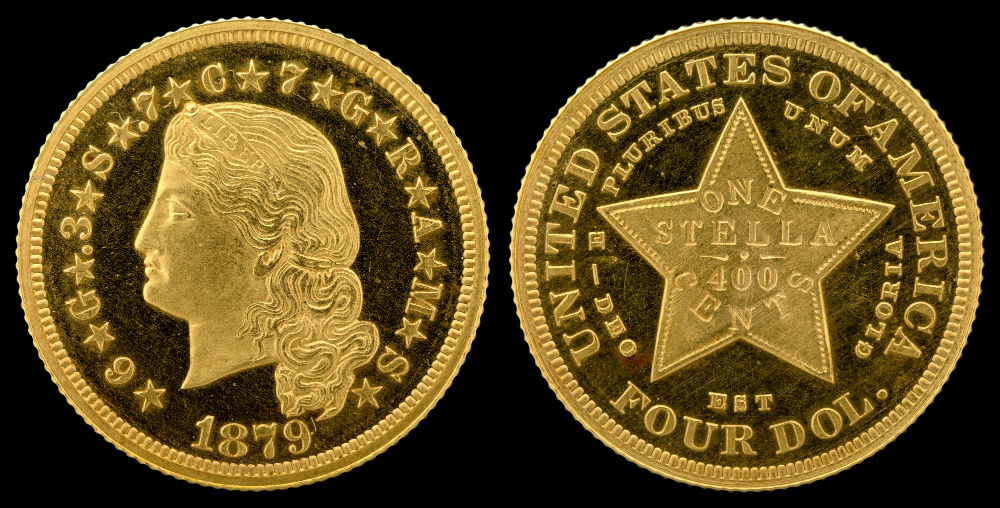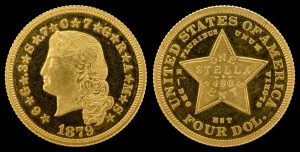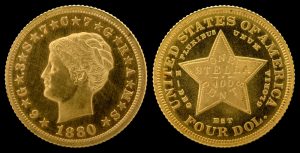The Four Dollar Stella


The Four Dollar Stella is a popular and highly sought-after coin that has been captivating coin collectors for decades. This coin is one of the most valuable and recognizable coins in the world, and it is a must-have for any coin collector who is serious about building a comprehensive coin collection.
The Four Dollar Stella was first minted in 1879 and 1880, and it was produced by the United States Mint. The coin was designed to be used as a trade coin with other countries and was produced in two denominations: the four-dollar gold coin and the four-dollar paper note.
The Four Dollar Stella is unique among coins in that it was the first coin produced by the United States Mint to feature a portrait of a woman. The woman on the coin is Liberty, and she is depicted with a coronet on her head, a flowing gown, and a ribbon in her hair.
The Four Dollar Stella is also unique in that it features a unique edge design. The edge of the coin is comprised of 12 stars, which symbolize the 12 original colonies of the United States. This edge design is not found on any other coin produced by the United States Mint.
Collectors who are interested in acquiring a Four Dollar Stella should be aware that the coin is quite rare and highly valued. The coin is considered to be one of the most valuable coins in the world, and it is estimated that there are only a few hundred Four Dollar Stellas in existence today.
If you are looking to add the Four Dollar Stella to your coin collection, it is important to do your research and find a reputable coin dealer who can assist you in acquiring the coin. The Four Dollar Stella is a valuable and highly sought-after coin, and it is an excellent investment for coin collectors who are looking to build a comprehensive collection of rare and valuable coins.
History of the Four-Dollar Stella
It was during the first half of the 19th Century that the people of the United States became engrossed with the idea that the US has a “Manifest Destiny” to expand the American territory all over the continent. Manifest Destiny was a term invented by a well-known editor and columnist in the year 1895, John L. O’Sullivan. It became a controversial word and is still is up today.
When the 1870s came, the United States had become successful in securing its nation. It was then that the people started to focus more on territorial expansion and trade. The nation wanted to trade internationally and out of the border. However, since there was no international score or currency used for trade, the global exchange of goods and services proved to be difficult.
To resolve the issue, many countries agreed to create a coinage system that will be used and will be recognized worldwide to facilitate international trade. An international conference was made possible and was held in Paris. There were twenty nations attended the conference, and they agreed to adopt a coinage system made out of gold to make international trade possible, with the French franc as its base.
There were lots of people in the US Congress that believed the US can be the hub or center of the monetary system of the world. They responded by proposing several international gold coins. However, by the year 1871, many legislators wanted a silver dollar coin. The problem is, the value of silver is not performing well.
Because of the Comstock Lode, the US already had tons of silver. The overwhelming supply of silver in the market plummeted more when the Germans used the gold standard after letting many silvers in the marketplace. Since there was too much silver available, the value of silver decreased dramatically. The US now has very little use for Silver.
With very little demand and a sky-high supply of Silver, the owners of the western mines had to find ways in order to not lose the US Mint as their valued customer. Lucky for them, the three representatives of the Congress – William Kelley, Jason Kasson, and Richard Bland have always advocated and were almost always successful in promoting Nickels and Silvers.
In 1873, the first two representatives contributed to making sure that the conversion of dime, quarter, and half a dollar were converted to the metric system. The legislation made sure silver got free coinage for use in the Orient by means of a trade dollar. The US mint produced almost 36 million pieces of large silver. This move may not have been very helpful in boosting the exchange of goods and services with the Far East, but it definitely helped Silver mine owners have some earnings.
Those with Nickels were not left behind. After the production of the Three and Five Cents, Silver was stopped, and Nickel was used to coin such denominations. After the Bland-Allison Act was pushed through, Silver made a comeback five years later as the government had to buy two to four million ounces of it every month for the silver dollar coins
In 1879, Kasson again tried to propose another coin that the US can use for international trade. The proposed coin was a Four Dollar Coin called “goloid” and will be composed of 96% Silver with the remaining 10% as Gold. He made the proposal as an attempt to still advocate for Silver while appeasing those in favor of Gold. The Goloid was meant to compete with same-valued coins like the Italian 20 Lire, French 20 Franc, Austrian and Dutch 8 Florin, as well as the Spanish 20 Pesetas Coins.
The proposed Four-Dollar Coin received a new name – Stella which means Star in Latin. The Star was comparable to the Eagle wherein both are a favorite when it comes to national representation of US coins. In 1879, the Stella Dollar Coin was produced along with patterns of “quintuple Stella and the gold coin.
The Four Dollar Stella has two designs for the head or obverse side of the coin. Charles Barber engraved a design depicting Miss Liberty with her long flowing hair while George Morgan made Miss Liberty with a coiled hair or in simpler terms, her hair was tied in a bun. On both designs, the obverse had Miss Liberty encircled by *6*G*.3*S*.7*C*7*G*R*A*M*S*. The lettering states the proportions of Copper, Silver, and Gold in the Stella Coin.
As for the other side of the coin, also known as the reverse, it has a central design featuring a large five-pointed star. Inside the star lies the inscriptions ONE/STELLA/400/CENTS. The United States motto E PLURIBUS UNUM and DEO EST GLORIA (a Latin Motto which means God is Glorious) encircles the star. In turn, UNITED STATES OF AMERICA and the denomination FOUR DOL. encircles both mottos.
The Four Dollar Stella has a reeded edge, weighs 7.00 grams and has a diameter of 22.00mm. It was made up of 86% Gold, 10% Copper and 4% Silver.
Unfortunately for the Four-Dollar Stella, it was never produced regularly. The number of coins produced or the mintage rate of the Four-Dollar Stella proved to be unreliable. It was believed that there are only 15 originals and 425 restrikes we produced for the 1879 FLOWING HAIR Four Dollar Stella. It was also believed that the 15 originals lacked the fine, parallel lines on the dies found on the nest issued Stella.
The Restriked versions of the 1879 Flowing Hair are considered the most commonly seen while the rest of the issues are extremely rare. Those with Coiled Hair are rare up until now and can only be seen when major collections open up for auctions.
The Four-Dollar Stella may be patterned, but these are still integrated into the regular coin series of the United States. However, since they are a collector’s item thanks to their rarity, these are typically collected by coin collectors and enthusiasts as Type Coins (collected based on its type or design).
Since these historic and extremely rare coins are expensive, it is obvious that only the rich and lucky collectors are able to get a hold of this precious US coin. The Four-Dollar Stellas were already very popular among collectors by the time these were minted. However, since there were very little of these ever produced, the supply was very limited.
Reports made by various newspapers revealed that in the 1880s, average coin collectors had a very difficult time of acquiring Stellas from the US Mint. The madams that manage the most famous brothels, also known as bordellos, however, can be seen with pieces of looped Stella specimens dangling on their necks.
Just two years after the Four Dollar Stellas were issued, the Mint has abandoned its production. The public, as well as the Congress, forgot about the fascinating coin, while the United States’ dream of creating a recognized and tradable US coin in the past are now only remembered by coin collectors.
The Two Types of Four Dollar Stella
1. Type 1 Flowing Hair Four Dollar Stella

The first type of the Four Dollar Stella was engraved by Charles Baber who was the 6th Chief Engraver in the US Mints. His design for the obverse features Miss Liberty with the long flowing hair pulled down.
1. Type 2 Coiled Hair Four Dollar Stella

The second type of the Four Dollar Stella was engraved by George T. Morgan. His design for the obverse features Miss Liberty with her hair coiled and kept up in a bun.
The Four Categories of the Four Dollar Stella
1879 $4 Flowing Hair (Proof)
The 1879 Flowing Hair Four Dollar Stella was a Type 1 variety. The obverse was created by Charles Barber. The total number of coins minted for this variety is 425 coins. An auction record for an NGC-graded PR67 (Cameo) Stella amounting to $1,040,000.00 took place in 2013 by the Bonham’s.
1879 $4 Coiled Hair (Proof)
The 1879 Coiled Hair Four Dollar Stella was a Type 2 variety. The obverse was created by George T. Morgan. The total number of coins minted for this variety is 20 coins. An auction record for a PCGS-graded PR65 Stella amounting to $881,250.00 took place in 2013 by the Heritage.
1880 $4 Flowing Hair (Proof)
The 1880 Flowing Hair Four Dollar Stella was a Type 1 variety. The obverse was created by Charles Barber. The total number of coins minted for this variety are 35 coins. An auction record for an NGC-graded PR67 Stella amounting to $959,400.00 took place in 2013 by the Bonham’s.
1880 $4 Coiled Hair (Proof)
The 1880 Coiled Hair Four Dollar Stella was a Type 2 variety. The obverse was created by George T. Morgan. The total number of coins minted for this variety is 10 coins. An auction record for an NGC-graded PR66 Stella amounting to $2,570,000.00 took place in 2013 by the Bonhams. this is considered as one of the most valuable US Gold Coin.
Collecting Four Dollar Stellas
Since the Stellas have a very low mintage rate, were produced only within two years, and never made it to circulation, the coin is considered scandalous but nevertheless, a historic coin is an extremely expensive one.
The price for a Stella will depend on the variety, rarity, and condition of the coin. The Type 1 varieties with Flowing Haired Miss Liberty Design cost far less than the extremely rare Coiled Hair Stellas. According to the PCGS, one can buy a Type 1 Four Dollar Stella starting $57,500.00 and up to $950,000.00. As for the Type 2 Four Dollar Stella, you can purchase one from $300,000.00 up to $2,000,000.00.
For the price guide of the Four Dollar Stella, one can on PCGS.
The four issues of Stellas do exist in Gem specimens, but there were a huge number of the Four-Dollar Stella that has some kind of impairments after being used as a form of jewelry. When collecting Stellas, be sure to check for friction on Miss Liberty’s face as well as the Star on the other side of the coin.
In conclusion, the Four Dollar Stella is a must-have coin for any serious coin collector. Its unique design and rarity make it a valuable addition to any coin collection, and it is sure to be an excellent investment for years to come.
References:
PCGS, NGCCoin, U.S. Rare Coin Investments, GovMint
Featured Image Source: US Mint (coin), National Numismatic Collection (photograph by Jaclyn Nash), NNC-US-1879-G$4-Stella Pattern (Flowing Hair), size by Bonnie Mattie, CC BY-SA 4.0
